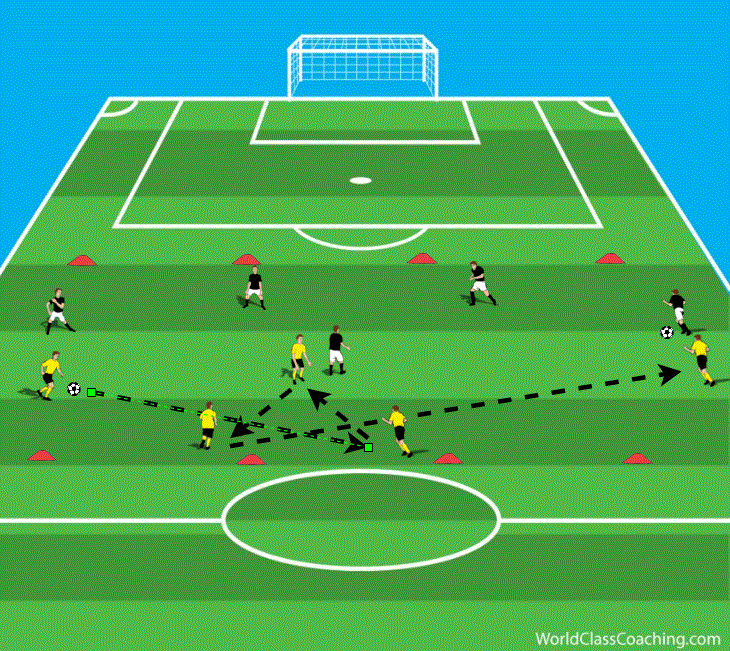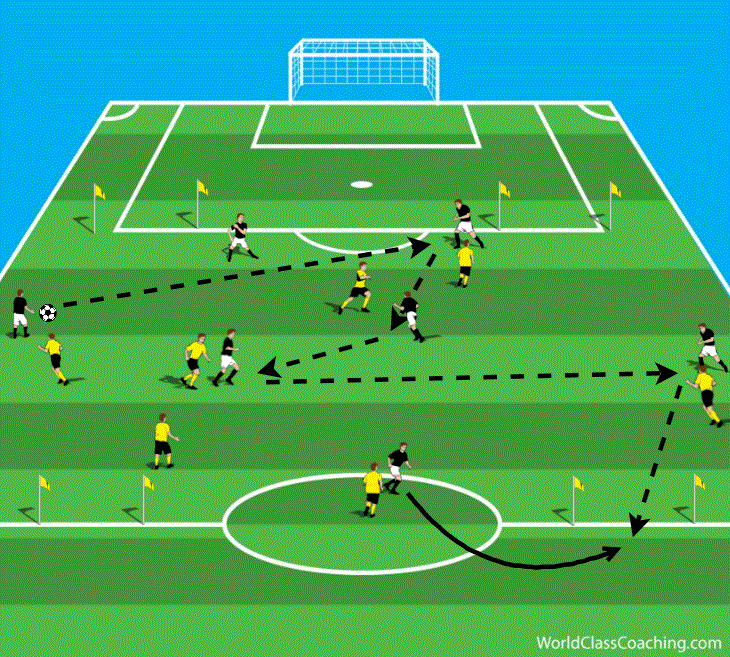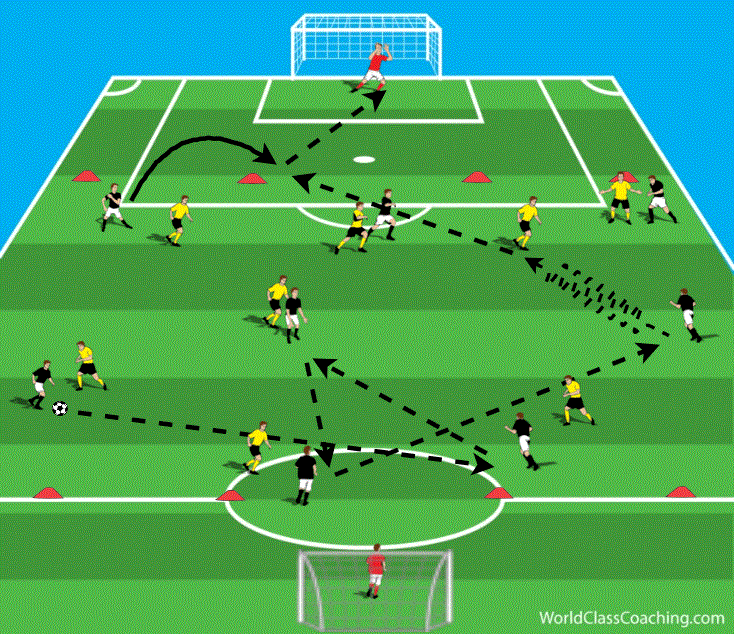By Chris Kouns
USSF A License (USSF Coaching Education Instructor) – NSCAA Premier Diploma (NSCAA Coaching Education Associate Staff Coach) – Head Women’s Soccer Coach – Georgia Gwinnett College
These activities are designed to allow the different lines of players to better understand and work on movement and possession in their zone as well as how to eliminate the last line of defenders when going to goal.
General Principles
In these activities we are working on the speed of recognition that we should realize when we are numbers down and then find a way to get the ball into a situation where we are numbers up so that we will be able to keep possession and attack the goal.
Exercise #1
Two balls are working at the same time, without any defenders, as pressure will come from the fact there are ten players working in a confined space. Focus is on developing the movement and body position necessary to efficiently move the ball from one side of the field to the other while utilizing a midfielder and the backs. When the ball gets to the other side back plays it to the opposite back and the pattern continues going the other direction.
Coaching Points
- Midfielder should drift away from initial pass to center back allowing for a better angle to receive the ball
- As center back plays ball to holding midfielder the opposite center back will check underneath to release pressure and offer an option
- While that movement is taking place opposite back is moving into a position to see the ball in a clear path to their feet while still holding their width
- As the ball travels across the midfielder will recycle their position to prepare to receive another ball.
Exercise #2
Two teams are set up in a 4-3 formation going in a specific direction. At the end of each side of the grid will be two flag goals roughly ten (10) yards wide each. Goals should be on opposite sides of the end line to encourage success when recognizing space is closed and numbers down on one side of the field. Goal is scored when a team has a player make a diagonal run in behind a gate and receive a ball played through the gate. Timing is critical so you cannot get behind gate and stand…. It must hit the player running.
Coaching Points
- If possible look to utilize center backs as an option to keep possession when numbers down.
- Movement of the backline should be opening up for the ball at angles so that they can see and play the ball quickly.
- One of the central midfielders should work to be an option for the center backs, also at a supporting angle and not in line with them
- One of the opposite central midfielders (a more attacking one) should be higher up the pitch and at an opposite angle from the defensive midfielder to act as a transition point.
- As soon as there is a passing lane that appears for an angled ball into the gate the highest player should drift away from their defender then slash back across so they can get the ball running.
- If there are more than one player available on the side where you are numbers up it is fine for both players to make runs on different sides of the gate or at different levels if they are on the same side.
Exercise #3
Two teams are set up in a 4-3-1 (plus GK) formation going in a specific direction. At the end of each side of the grid will be an “offside” line that players cannot cross unless there is a pass on the way to “eliminate” those “defenders”. Cones will be roughly 16/18 yards from goal to offer enough space to time runs but also offer enough opportunity to GK to come off line and pick off passes that are not timed well.
Coaching Points
- Utilization of the same movements of defenders and midfielders as the last two exercises. Each one should pay attention to the body position (availability) they are offering to keep possession, as well as, the ability to quickly change the point of attack to eliminate lines of defenders when we are numbers up.
- Attacking midfielder should work with striker to recognize if “leaving” a ball is the right choice or if receiving it and then dribbling or playing is the right choice. Each option is based on space and communication.
- Focus on importance of the player getting the ball in behind the defenders to “drift away” while defenders are looking at the ball and then “appear” behind them as the ball arrives with a diagonal run.
- The timing of the passes from backs to midfielders and midfielders to strikers should be made as the player with the ball is “engaging” a defender as this will make the other defenders hold their shape and allow the player on the ball to see the space that we can successfully attack through.
- Pace of passes, dribbling and decisions should increase in direct relation to the distance from goal. The closer you are to scoring the faster your decision and play must be in order to break down the defense and create scoring opportunities.
By Chris Kouns: USSF A License (USSF Coaching Education Instructor) – NSCAA Premier Diploma (NSCAA Coaching Education Associate Staff Coach) – Head Coach Georgia Gwinnet College Women’s Soccer (GA)





